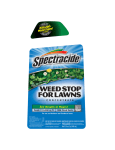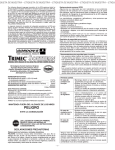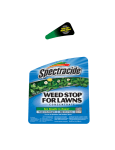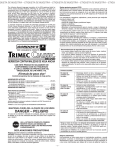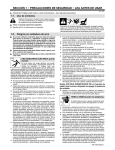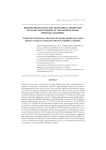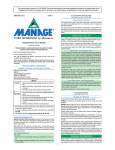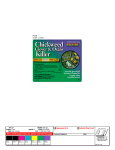Download Lawn Weed Killer - KellySolutions.com
Transcript
73759 Dilutable Concentrate Lawn Weed Killer Kills dandelions and many other broadleaf weeds Will not harm lawns Concentrado para dilución Active Ingredients: * 2,4-D, dimethylamine salt . . . . . . . . . . . . . . . . . . . . . . 7.59% † Mecoprop, dimethylamine salt . . . . . . . . . . . . . . . . 3.66% ‡ Dicamba, dimethylamine salt . . . . . . . . . . . . . . . . . . 0.84% Other Ingredients . . . . . . . . . . . . . . . . . . . . . . . . . . . . . . 87.91% *0.543 lb. 2,4-D acid equivalent per gallon or 6.30%. †0.26 lb. Mecoprop acid equivalent per gallon or 3.02% ‡ 0.059 lb. Dicamba acid equivalent per gallon or 0.69% F73759D1 Herbicida para malezas de césped KEEP OUT OF REACH OF CHILDREN back booklet for additional CAUTION Seeprecautionary statements MANTENGA FUERA DEL ALCANCE DE LOS NIÑOS el folleto en la parte posterior para obtener PRECAUCIÓN Consulte información adicional sobre las precauciones. Herbicide NET CONTENTS 32 fl. oz. (946 mL) boca a una persona que haya perdido el conocimiento. En caso de contacto con la piel: Lave la ropa contaminada y las áreas afectadas con abundante agua y jabón. Si la irritación persiste busque atención médica. En caso de contacto con los ojos: Enjuague los ojos con abundante agua. Si la irritación persiste consulte a un médico. Si se inhala: Saque a la víctima al aire fresco. Aplique respiración artificial si está indicada. RIESGOS PARA EL MEDIO AMBIENTE No aplique bajo condiciones que puedan provocar un posible contacto o arrastre del aerosol sobre comida, forraje, vegetales, plantas ornamentales, u otras plantas deseables que pudieran resultar dañadas o sobre cultivos que pudieran quedar inutilizados para la venta, uso o consumo. Este producto es tóxico para los peces y los invertebrados acuáticos. El arrastre o el escurrimiento pueden afectar de manera adversa a los peces, los invertebrados acuáticos y las plantas que no son el objetivo del tratamiento. No aplique directamente sobre el agua. No contamine el agua cuando elimine las aguas de lavado del equipo. En la mayoría de los casos, la contaminación del agua subterránea por herbicidas de tipo fenoxi como el 2,4-D ha sido asociada con lugares de mezclado/rellenado y eliminación. Se debe tener mucho cuidado al manipular pesticidas tipo 2,4-D en dichos lugares para evitar la contaminación de las fuentes de agua subterránea. El uso de sistemas cerrados para mezclar o transferir este pesticida, reducirá la probabilidad de derrames. La ubicación del equipo de mezclado/rellenado sobre un cojín impermeable para contener derrames, ayudará a evitar la contaminación del agua subterránea. ADVERTENCIA: El comprador asume total responsabilidad en caso de no seguir las instrucciones sobre seguridad y modo de empleo. 11 Ace Lawn Weed Killer controls more than 33 troublesome weeds including Dandelions, Clover, Plantain and Wild Onion. It even kills woody weeds like Poison Ivy and Poison Oak in both Northern and Southern lawns.This concentrated formula covers 16,000 sq. ft. of Southern grasses or 8,000 sq. ft. of Northern grasses per quart. NOTE: DO NOT USE ON FLORATAM VARIETY OF ST. AUGUSTINE GRASS IN FLORIDA. WEEDS CONTROLLED: Bedstraw Knotweed Purslane Black Medic Lambsquarters Ragweed Buckhorn Lespedeza Sheep Sorrel Burdock Mallow Shepherd’s Purse Chickweed Morning Glory Speedwell Chicory Oxalis Spurge (Spotted) Clover Peppergrass Wild Carrot Dandelion Pepperweed Wild Garlic Dock Pigweed Wild Lettuce Ground Ivy Plantain Wild Onion Heal-All Poison Ivy Yarrow and Henbit Poison Oak other problem broadleaf weeds See directions inside booklet • Vea las instrucciones en el folleto Distributed by Chemsico, Division of United Industries Corp., P.O. Box 142642, St. Louis, MO 63114-0642 EPA Reg. No. 478-121-9688; EPA Est. No. 9688-MO-1 Form 73759D1 Manufactured in USA for Ace Hardware Corp., Oak Brook, Illinois, 60523, USA ©2002 Fabricado en EE. UU. por Ace Hardware Corp., Oak Brook, Illinois, 60523, EE. UU. ©2002 10 READ ENTIRE LABEL BEFORE USE DIRECTIONS FOR USE It is a violation of Federal law to use this product in a manner inconsistent with its labeling. SHAKE WELL BEFORE USING. People and pets should not be allowed in treated areas until spray has dried. MEASUREMENT CALCULATIONS: Calculate square feet by multiplying length by width. 1 fl.oz. = 2 tablespoons (6 teaspoons); 2 fl.oz. = 4 tablespoons; 4 fl.oz. = 1/2 cup; 8 fl.oz. = 1 cup; 16 fl.oz. = 1 pint; 32 fl.oz. = 1 quart WHEN TO USE 2. Lawn Weed Killer BACK-FRONT COVER 1 1. Dilutable Concentrate SPRING: The best time to treat weeds is when they are small and growing. FALL: Many problem weeds germinate in the fall and treatment then will eliminate many of next year’s weeds. HOW MUCH TO USE SPOT TREATMENT To spray small areas or individual weeds, use a pressure sprayer for better control. Do not use a hose-end sprayer. Mix 1 fl. oz. (2 Tbsp.) in one gallon of water. Shake well before spraying. Be certain to wet each weed. ENTIRE LAWN PRESSURE SPRAYERS Measure amount of concentrate from chart below into sprayer tank and dilute with 1 gallon of water. Close tank sprayer and shake well before spraying. Use a spray pattern that gives small spray droplets without any fine mist to treat 250 sq. ft. AMOUNT OF CONCENTRATE IN 1 GALLON WATER REQUIRED TO TREAT 250 SQ. FT. 5. No permita que el aerosol alcance los vegetales o las plantas ornamentales puesto que puede provocarles daños. No pulverice alrededor de las raíces de árboles ni plantas ornamentales. El Trifolium sp. (Clover) resultará dañado si se lo pulveriza. 6. Cuando utilice un pulverizador con aplicador tipo manguera o un pulverizador a presión evite aerosoles muy finos porque éstos pueden ser arrastrados y dañar otras plantas. 7. Si algunas malezas resistentes no han sido eliminadas dentro de las primeras 3 semanas, repita el tratamiento. No es necesaria una aplicación en toda la extensión, siga las instrucciones para el tratamiento por manchas. ALMACENAMIENTO Y ELIMINACIÓN Almacene en un lugar fresco y seco, no exponga al calor ni al fuego. No vuelva a utilizar el envase. Enjuáguelo muy bien antes de desecharlo en la basura. Envuelva bien el envase en varias capas de periódico y deséchelo en la basura. PRECAUCIONES Peligroso para los seres humanos y los animales domésticos PRECAUCIÓN: Nocivo si se ingiere o se absorbe a través de la piel. Evite inhalar el vapor y la niebla del aerosol. Evite el contacto con la piel, los ojos o la ropa. Cuando utilice este producto use camisa de manga larga, pantalones largos, calcetines, zapatos y guantes de goma/hule. Cuando aplique este producto utilice gafas de seguridad. Luego de utilizar este producto, enjuague los guantes antes de quitárselos, quítese la ropa y lávela por separado antes de volver a usarla y rápidamente lávese bien las manos y la piel que estuvo expuesta, con agua y jabón. Quítese la ropa mojada tan pronto como sea posible y tome una ducha. No permita que otras personas (aparte del aplicador) o mascotas ingresen en el área a tratar durante la aplicación. No entre en las áreas de tratamiento hasta que se haya secado el aerosol. El número máximo de aplicaciones por difusión por lugar de tratamiento, es de 2 por año. GRASS TYPE AMOUNT OF CONCENTRATE PRIMEROS AUXILIOS St. Augustine*, Bahia, Centipede Bermuda, Bentgrass Bluegrass, Fescue, Rye, Zoysia 1/2 fl. oz. (1 Tbsp.) 2/3 fl. oz. (4 tsp.) 1 fl. oz. (2 Tbsp.) Si se ingiere: Llame inmediatamente a un médico o a un centro de toxicología. Beba 1 ó 2 vasos de agua e induzca el vómito tocando la parte posterior de la garganta con el dedo. Repita hasta que el vómito sea claro. Nunca induzca el vómito ni administre nada por *DO NOT USE ON FLORATAM VARIETY OF ST. AUGUSTINE GRASS IN FLORIDA. boca a una persona que haya perdido el conocimiento. En caso de contacto con la piel: Lave la ropa contaminada y las áreas afectadas con abundante agua y jabón. Si la irritación persiste busque atención médica. En caso de contacto con los ojos: Enjuague los ojos con abundante agua. Si la irritación persiste consulte a un médico. Si se inhala: Saque a la víctima al aire fresco. Aplique respiración artificial si está indicada. RIESGOS PARA EL MEDIO AMBIENTE No aplique bajo condiciones que puedan provocar un posible contacto o arrastre del aerosol sobre comida, forraje, vegetales, plantas ornamentales, u otras plantas deseables que pudieran resultar dañadas o sobre cultivos que pudieran quedar inutilizados para la venta, uso o consumo. Este producto es tóxico para los peces y los invertebrados acuáticos. El arrastre o el escurrimiento pueden afectar de manera adversa a los peces, los invertebrados acuáticos y las plantas que no son el objetivo del tratamiento. No aplique directamente sobre el agua. No contamine el agua cuando elimine las aguas de lavado del equipo. En la mayoría de los casos, la contaminación del agua subterránea por herbicidas de tipo fenoxi como el 2,4-D ha sido asociada con lugares de mezclado/rellenado y eliminación. Se debe tener mucho cuidado al manipular pesticidas tipo 2,4-D en dichos lugares para evitar la contaminación de las fuentes de agua subterránea. El uso de sistemas cerrados para mezclar o transferir este pesticida, reducirá la probabilidad de derrames. La ubicación del equipo de mezclado/rellenado sobre un cojín impermeable para contener derrames, ayudará a evitar la contaminación del agua subterránea. ADVERTENCIA: El comprador asume total responsabilidad en caso de no seguir las instrucciones sobre seguridad y modo de empleo. 11 Ace Lawn Weed Killer controls more than 33 troublesome weeds including Dandelions, Clover, Plantain and Wild Onion. It even kills woody weeds like Poison Ivy and Poison Oak in both Northern and Southern lawns.This concentrated formula covers 16,000 sq. ft. of Southern grasses or 8,000 sq. ft. of Northern grasses per quart. NOTE: DO NOT USE ON FLORATAM VARIETY OF ST. AUGUSTINE GRASS IN FLORIDA. WEEDS CONTROLLED: Bedstraw Knotweed Purslane Black Medic Lambsquarters Ragweed Buckhorn Lespedeza Sheep Sorrel Burdock Mallow Shepherd’s Purse Chickweed Morning Glory Speedwell Chicory Oxalis Spurge (Spotted) Clover Peppergrass Wild Carrot Dandelion Pepperweed Wild Garlic Dock Pigweed Wild Lettuce Ground Ivy Plantain Wild Onion Heal-All Poison Ivy Yarrow and Henbit Poison Oak other problem broadleaf weeds See directions inside booklet • Vea las instrucciones en el folleto Distributed by Chemsico, Division of United Industries Corp., P.O. Box 142642, St. Louis, MO 63114-0642 EPA Reg. No. 478-121-9688; EPA Est. No. 9688-MO-1 Form 73759D1 Manufactured in USA for Ace Hardware Corp., Oak Brook, Illinois, 60523, USA ©2002 Fabricado en EE. UU. por Ace Hardware Corp., Oak Brook, Illinois, 60523, EE. UU. ©2002 10 READ ENTIRE LABEL BEFORE USE DIRECTIONS FOR USE It is a violation of Federal law to use this product in a manner inconsistent with its labeling. SHAKE WELL BEFORE USING. People and pets should not be allowed in treated areas until spray has dried. MEASUREMENT CALCULATIONS: Calculate square feet by multiplying length by width. 1 fl.oz. = 2 tablespoons (6 teaspoons); 2 fl.oz. = 4 tablespoons; 4 fl.oz. = 1/2 cup; 8 fl.oz. = 1 cup; 16 fl.oz. = 1 pint; 32 fl.oz. = 1 quart WHEN TO USE 2. Lawn Weed Killer BACK-FRONT COVER 1 1. Dilutable Concentrate SPRING: The best time to treat weeds is when they are small and growing. FALL: Many problem weeds germinate in the fall and treatment then will eliminate many of next year’s weeds. HOW MUCH TO USE SPOT TREATMENT To spray small areas or individual weeds, use a pressure sprayer for better control. Do not use a hose-end sprayer. Mix 1 fl. oz. (2 Tbsp.) in one gallon of water. Shake well before spraying. Be certain to wet each weed. ENTIRE LAWN PRESSURE SPRAYERS Measure amount of concentrate from chart below into sprayer tank and dilute with 1 gallon of water. Close tank sprayer and shake well before spraying. Use a spray pattern that gives small spray droplets without any fine mist to treat 250 sq. ft. AMOUNT OF CONCENTRATE IN 1 GALLON WATER REQUIRED TO TREAT 250 SQ. FT. 5. No permita que el aerosol alcance los vegetales o las plantas ornamentales puesto que puede provocarles daños. No pulverice alrededor de las raíces de árboles ni plantas ornamentales. El Trifolium sp. (Clover) resultará dañado si se lo pulveriza. 6. Cuando utilice un pulverizador con aplicador tipo manguera o un pulverizador a presión evite aerosoles muy finos porque éstos pueden ser arrastrados y dañar otras plantas. 7. Si algunas malezas resistentes no han sido eliminadas dentro de las primeras 3 semanas, repita el tratamiento. No es necesaria una aplicación en toda la extensión, siga las instrucciones para el tratamiento por manchas. ALMACENAMIENTO Y ELIMINACIÓN Almacene en un lugar fresco y seco, no exponga al calor ni al fuego. No vuelva a utilizar el envase. Enjuáguelo muy bien antes de desecharlo en la basura. Envuelva bien el envase en varias capas de periódico y deséchelo en la basura. PRECAUCIONES Peligroso para los seres humanos y los animales domésticos PRECAUCIÓN: Nocivo si se ingiere o se absorbe a través de la piel. Evite inhalar el vapor y la niebla del aerosol. Evite el contacto con la piel, los ojos o la ropa. Cuando utilice este producto use camisa de manga larga, pantalones largos, calcetines, zapatos y guantes de goma/hule. Cuando aplique este producto utilice gafas de seguridad. Luego de utilizar este producto, enjuague los guantes antes de quitárselos, quítese la ropa y lávela por separado antes de volver a usarla y rápidamente lávese bien las manos y la piel que estuvo expuesta, con agua y jabón. Quítese la ropa mojada tan pronto como sea posible y tome una ducha. No permita que otras personas (aparte del aplicador) o mascotas ingresen en el área a tratar durante la aplicación. No entre en las áreas de tratamiento hasta que se haya secado el aerosol. El número máximo de aplicaciones por difusión por lugar de tratamiento, es de 2 por año. GRASS TYPE AMOUNT OF CONCENTRATE PRIMEROS AUXILIOS St. Augustine*, Bahia, Centipede Bermuda, Bentgrass Bluegrass, Fescue, Rye, Zoysia 1/2 fl. oz. (1 Tbsp.) 2/3 fl. oz. (4 tsp.) 1 fl. oz. (2 Tbsp.) Si se ingiere: Llame inmediatamente a un médico o a un centro de toxicología. Beba 1 ó 2 vasos de agua e induzca el vómito tocando la parte posterior de la garganta con el dedo. Repita hasta que el vómito sea claro. Nunca induzca el vómito ni administre nada por *DO NOT USE ON FLORATAM VARIETY OF ST. AUGUSTINE GRASS IN FLORIDA. 9 2 ONZAS DE CONCENTRADO A USAR PARA Stenatophrum secundatum (St. Augustine*), Paspalum notatum (Bahia), Eremochloa ophiuroides (Centipede) Pies cuadrados a tratar Galones de agua Onza fluida 1/2 250 1 1,000 4 5,000 20 8,000 32 Cynodon dactylon (Bermuda), Agrostis sp. (Bentgrass) Pies cuadrados a tratar Galones de agua 2 10 16 Onza fluida 2/3 250 1 1,000 4 2 2/3 5,000 20 13 1/3 8,000 32 21 1/3 Boutelova gracilis (Bluegrass), Festuca sp. ( Fescue), Secale cereale (Rye), Zoysia japonica (Zoysia) Pies cuadrados a tratar Galones de agua Onza fluida 250 1,000 5,000 8,000 1 4 20 32 1 4 20 32 * NO LO UTILICE EN LA VARIEDAD FLORATAM DEL PASTO STENATOPHRUM SECUNDATUM (ST. AUGUSTINE) EN LA FLORIDA. CONSEJOS DE USO 1. Para obtener mejores resultados, corte el césped antes de tratar las malezas. 2. No trate las malezas cuando la temperatura del aire sea superior a 85ºF porque puede dañar el pasto. 3. No riegue dentro de las 6 horas posteriores al tratamiento. Si llueve dentro de las 6 horas posteriores a la aplicación, el resultado puede ser un control de malezas deficiente. 4. Para céspedes nuevos, trátelos dentro de las 24 horas posteriores a la siembra. Para céspedes establecidos, espere 3 semanas luego del tratamiento para volver a sembrar. Una vez que el pasto nuevo ha comenzado a crecer, espere hasta que alcance una altura de 2 pulgadas antes de tratarlo. 3 St. Augustine*, Bahia, Centipede 1/2 2 10 16 Bermuda, Bentgrass 2/3 2-2/3 13-1/3 21-1/3 1. From the chart below, determine amount of concentrate to be applied for each 250 sq. ft. of lawn. 2. Fill sprayer jar with enough concentrate to cover area to be treated. Do not add water to sprayer. 3. Set dial on sprayer to the setting from the chart below. 4. Attach sprayer to hose. Extend hose to the farthest area of lawn to be treated and work back toward faucet so that you do not walk over treated areas. Apply evenly to lawn. EXAMPLE: To treat 1,000 sq. ft. of Fescue lawn, add 4 fl. oz. of concentrate to the sprayer with sprayer dial set on 1 fl. oz. Check the directions you received when you purchased your sprayer for further details on the proper use of your dial sprayer. GRASS TYPE St. Augustine*, Bahia, Centipede Bermuda, Bentgrass Bluegrass, Fescue, Rye, Zoysia AREA TREATED OZ. IN SPRAYER 250 sq. ft. 1,000 sq. ft. 250 sq. ft. 1,000 sq. ft. 250 sq. ft. 1,000 sq. ft. 1/2 fl. oz. 2 fl. oz. 2/3 fl. oz. 2-2/3 fl. oz. 1 fl. oz. 4 fl. oz. DIAL SETTING 1/2 fl. oz. 2/3 fl. oz. 1 fl. oz. *DO NOT USE ON FLORATAM VARIETY OF ST. AUGUSTINE GRASS IN FLORIDA. “CONCENTRATE-PLUS-WATER” SPRAYERS For sprayers that require addition of water as well as concentrate prior to application: 1. From the chart on the next page, determine amount of concentrate required to treat each 250 sq. ft. of lawn. 2. Pour concentrate into the sprayer jar to the required “fl. oz.” level. 3. Then add the appropriate amount of water to the “gals.” level. Replace sprayer top on jar and shake well before spraying. 4. Attach sprayer to hose. Extend hose to the farthest area of lawn to be treated and work back toward faucet so that you do not walk over treated areas. Apply evenly to lawn. EXAMPLE: To treat 1,000 sq. ft. of Fescue pour in concentrate to the 4 fl. oz. mark and add water to the 4 gallon mark. Check the directions you received when you purchased your sprayer for further details on the proper use of your sprayer. 8 OUNCES OF CONCENTRATE TO USE FOR: Sq. Ft. to be Treated 250 1,000 5,000 8,000 HOSE-END SPRAYERS “CONCENTRATE ONLY” (DIAL) SPRAYERS Bluegrass, Fescue, Gallons Rye, Zoysia of Water 1 1 4 4 20 20 32 32 *DO NOT USE ON FLORATAM VARIETY OF ST. AUGUSTINE GRASS IN FLORIDA. USE TIPS 1. For best results, mow before treating weeds. 2. Do not treat when air temperatures exceed 85˚F or damage to grass may occur. 3. Do not water within 6 hours after treatment. Poor weed control may result if rainfall occurs within 6 hours of application. 4. For new lawns, treat within 24 hours after seeding. On established lawns, wait 3 weeks after treatment before reseeding. Once new grass has started to grow, wait until it has reached a height of 2 inches before treating. 5. Do not allow spray to get on vegetables or ornamental plants since injury may result. Do not spray around roots of trees and ornamentals. Clover will be damaged if sprayed. 6. Whether using a hose-end sprayer or pressure sprayer, avoid sprays which are too fine because they can drift and damage other plants. 7. If certain tough weeds are not dead within 3 weeks, repeat treatment. Broadcast application is not necessary; follow spot treatment directions. STORAGE AND DISPOSAL Store in a cool, dry area away from heat or open flame. Do not reuse container. Rinse thoroughly before discarding in trash. Securely wrap in several layers of newspaper and discard container in trash. PRECAUTIONARY STATEMENTS Hazards to Humans and Domestic Animals CAUTION: Harmful if swallowed or absorbed through skin. Avoid breathing vapor and spray mist. Avoid contact with skin, eyes and Boutelova gracilis (Bluegrass), Festuca sp. (Fescue), Secale cereale (Rye), Zoysia japonica (Zoysia) 1 onza fluida posición del selector = 250 pies cuadrados área = 1 onza fluida en el pulverizador 1,000 pies cuadrados área = 4 onzas fluidas en el pulverizador * NO LO UTILICE EN LA VARIEDAD FLORATAM DEL PASTO STENATOPHRUM SECUNDATUM (ST. AUGUSTINE) EN LA FLORIDA. PULVERIZADORES “PARA CONCENTRADO MÁS AGUA” Para los pulverizadores que requieren, previo a la aplicación, el agregado de agua junto al concentrado: 1. Utilizando la tabla en la siguiente página, determine la cantidad de concentrado requerida por cada 250 pies cuadrados de césped a tratar. 2. Vierta el concentrado dentro de la jarra del pulverizador hasta el nivel de “onza fluida” requerido. 3. Luego agregue la cantidad apropiada de agua hasta el nivel de “galones”. Vuelva a poner la tapa del pulverizador sobre la jarra y agite bien antes de pulverizar. 4. Una el pulverizador a la manguera. Extienda la manguera hasta el lugar a tratar que se encuentre más alejado y trabaje volviendo hacia el grifo de modo de no caminar sobre las áreas tratadas. Aplique uniformemente sobre el césped. EJEMPLO: Para tratar 1,000 pies cuadrados de Festuca sp. (Fescue), agregue concentrado hasta la marca de 4 onzas fluidas y luego agregue agua hasta la marca de 4 galones. Por mayores detalles sobre el uso apropiado de su pulverizador, revise las indicaciones que recibió al adquirirlo. 9 2 ONZAS DE CONCENTRADO A USAR PARA Stenatophrum secundatum (St. Augustine*), Paspalum notatum (Bahia), Eremochloa ophiuroides (Centipede) Pies cuadrados a tratar Galones de agua Onza fluida 1/2 250 1 1,000 4 5,000 20 8,000 32 Cynodon dactylon (Bermuda), Agrostis sp. (Bentgrass) Pies cuadrados a tratar Galones de agua 2 10 16 Onza fluida 2/3 250 1 1,000 4 2 2/3 5,000 20 13 1/3 8,000 32 21 1/3 Boutelova gracilis (Bluegrass), Festuca sp. ( Fescue), Secale cereale (Rye), Zoysia japonica (Zoysia) Pies cuadrados a tratar Galones de agua Onza fluida 250 1,000 5,000 8,000 1 4 20 32 1 4 20 32 * NO LO UTILICE EN LA VARIEDAD FLORATAM DEL PASTO STENATOPHRUM SECUNDATUM (ST. AUGUSTINE) EN LA FLORIDA. CONSEJOS DE USO 1. Para obtener mejores resultados, corte el césped antes de tratar las malezas. 2. No trate las malezas cuando la temperatura del aire sea superior a 85ºF porque puede dañar el pasto. 3. No riegue dentro de las 6 horas posteriores al tratamiento. Si llueve dentro de las 6 horas posteriores a la aplicación, el resultado puede ser un control de malezas deficiente. 4. Para céspedes nuevos, trátelos dentro de las 24 horas posteriores a la siembra. Para céspedes establecidos, espere 3 semanas luego del tratamiento para volver a sembrar. Una vez que el pasto nuevo ha comenzado a crecer, espere hasta que alcance una altura de 2 pulgadas antes de tratarlo. 3 St. Augustine*, Bahia, Centipede 1/2 2 10 16 Bermuda, Bentgrass 2/3 2-2/3 13-1/3 21-1/3 1. From the chart below, determine amount of concentrate to be applied for each 250 sq. ft. of lawn. 2. Fill sprayer jar with enough concentrate to cover area to be treated. Do not add water to sprayer. 3. Set dial on sprayer to the setting from the chart below. 4. Attach sprayer to hose. Extend hose to the farthest area of lawn to be treated and work back toward faucet so that you do not walk over treated areas. Apply evenly to lawn. EXAMPLE: To treat 1,000 sq. ft. of Fescue lawn, add 4 fl. oz. of concentrate to the sprayer with sprayer dial set on 1 fl. oz. Check the directions you received when you purchased your sprayer for further details on the proper use of your dial sprayer. GRASS TYPE St. Augustine*, Bahia, Centipede Bermuda, Bentgrass Bluegrass, Fescue, Rye, Zoysia AREA TREATED OZ. IN SPRAYER 250 sq. ft. 1,000 sq. ft. 250 sq. ft. 1,000 sq. ft. 250 sq. ft. 1,000 sq. ft. 1/2 fl. oz. 2 fl. oz. 2/3 fl. oz. 2-2/3 fl. oz. 1 fl. oz. 4 fl. oz. DIAL SETTING 1/2 fl. oz. 2/3 fl. oz. 1 fl. oz. *DO NOT USE ON FLORATAM VARIETY OF ST. AUGUSTINE GRASS IN FLORIDA. “CONCENTRATE-PLUS-WATER” SPRAYERS For sprayers that require addition of water as well as concentrate prior to application: 1. From the chart on the next page, determine amount of concentrate required to treat each 250 sq. ft. of lawn. 2. Pour concentrate into the sprayer jar to the required “fl. oz.” level. 3. Then add the appropriate amount of water to the “gals.” level. Replace sprayer top on jar and shake well before spraying. 4. Attach sprayer to hose. Extend hose to the farthest area of lawn to be treated and work back toward faucet so that you do not walk over treated areas. Apply evenly to lawn. EXAMPLE: To treat 1,000 sq. ft. of Fescue pour in concentrate to the 4 fl. oz. mark and add water to the 4 gallon mark. Check the directions you received when you purchased your sprayer for further details on the proper use of your sprayer. 8 OUNCES OF CONCENTRATE TO USE FOR: Sq. Ft. to be Treated 250 1,000 5,000 8,000 HOSE-END SPRAYERS “CONCENTRATE ONLY” (DIAL) SPRAYERS Bluegrass, Fescue, Gallons Rye, Zoysia of Water 1 1 4 4 20 20 32 32 *DO NOT USE ON FLORATAM VARIETY OF ST. AUGUSTINE GRASS IN FLORIDA. USE TIPS 1. For best results, mow before treating weeds. 2. Do not treat when air temperatures exceed 85˚F or damage to grass may occur. 3. Do not water within 6 hours after treatment. Poor weed control may result if rainfall occurs within 6 hours of application. 4. For new lawns, treat within 24 hours after seeding. On established lawns, wait 3 weeks after treatment before reseeding. Once new grass has started to grow, wait until it has reached a height of 2 inches before treating. 5. Do not allow spray to get on vegetables or ornamental plants since injury may result. Do not spray around roots of trees and ornamentals. Clover will be damaged if sprayed. 6. Whether using a hose-end sprayer or pressure sprayer, avoid sprays which are too fine because they can drift and damage other plants. 7. If certain tough weeds are not dead within 3 weeks, repeat treatment. Broadcast application is not necessary; follow spot treatment directions. STORAGE AND DISPOSAL Store in a cool, dry area away from heat or open flame. Do not reuse container. Rinse thoroughly before discarding in trash. Securely wrap in several layers of newspaper and discard container in trash. PRECAUTIONARY STATEMENTS Hazards to Humans and Domestic Animals CAUTION: Harmful if swallowed or absorbed through skin. Avoid breathing vapor and spray mist. Avoid contact with skin, eyes and Boutelova gracilis (Bluegrass), Festuca sp. (Fescue), Secale cereale (Rye), Zoysia japonica (Zoysia) 1 onza fluida posición del selector = 250 pies cuadrados área = 1 onza fluida en el pulverizador 1,000 pies cuadrados área = 4 onzas fluidas en el pulverizador * NO LO UTILICE EN LA VARIEDAD FLORATAM DEL PASTO STENATOPHRUM SECUNDATUM (ST. AUGUSTINE) EN LA FLORIDA. PULVERIZADORES “PARA CONCENTRADO MÁS AGUA” Para los pulverizadores que requieren, previo a la aplicación, el agregado de agua junto al concentrado: 1. Utilizando la tabla en la siguiente página, determine la cantidad de concentrado requerida por cada 250 pies cuadrados de césped a tratar. 2. Vierta el concentrado dentro de la jarra del pulverizador hasta el nivel de “onza fluida” requerido. 3. Luego agregue la cantidad apropiada de agua hasta el nivel de “galones”. Vuelva a poner la tapa del pulverizador sobre la jarra y agite bien antes de pulverizar. 4. Una el pulverizador a la manguera. Extienda la manguera hasta el lugar a tratar que se encuentre más alejado y trabaje volviendo hacia el grifo de modo de no caminar sobre las áreas tratadas. Aplique uniformemente sobre el césped. EJEMPLO: Para tratar 1,000 pies cuadrados de Festuca sp. (Fescue), agregue concentrado hasta la marca de 4 onzas fluidas y luego agregue agua hasta la marca de 4 galones. Por mayores detalles sobre el uso apropiado de su pulverizador, revise las indicaciones que recibió al adquirirlo. 7 CANTIDAD DE CONCENTRADO EN UN GALÓN DE AGUA PARA TRATAR 250 PIES CUADRADOS Stenatophrum secundatum (St. Augustine*), Paspalum notatum (Bahia), Eremochloa ophiuroides (Centipede) = 1/2 onza fluida (1 cucharada sopera) Cynodon dactylon (Bermuda), Agrostis sp. (Bentgrass) = 2/3 onza fluida (4 cucharaditas) Boutelova gracilis (Bluegrass), Festuca sp. (Fescue), Secale cereale (Rye), Zoysia japonica (Zoysia) = 1 onza fluida (2 cucharadas soperas) * NO LO UTILICE EN LA VARIEDAD FLORATAM DEL PASTO STENATOPHRUM SECUNDATUM (ST. AUGUSTINE) EN LA FLORIDA. PULVERIZADORES CON APLICADOR TIPO MANGUERA PULVERIZADORES (CON SELECTOR) “SÓLO PARA CONCENTRADO” 1. Utilizando las siguientes medidas, determine la cantidad de concentrado a ser aplicada por cada 250 pies cuadrados de césped. 2. Llene la jarra del pulverizador con la cantidad de concentrado suficiente como para cubrir el área a ser tratada. No agregue agua al pulverizador. 3. Fije el selector del pulverizador en la posición indicada abajo. 4. Una el pulverizador a la manguera. Extienda la manguera hasta el lugar a tratar que se encuentre más alejado y trabaje volviendo hacia el grifo de modo de no caminar sobre las áreas tratadas. Aplique uniformemente sobre el césped. EJEMPLO: Para tratar 1,000 pies cuadrados de césped Festuca sp. (Fescue), agregue 4 onzas fluidas de concentrado al pulverizador, con el selector del mismo fijado en la posición 1 onza fluida. Por mayores detalles sobre el uso apropiado de su pulverizador con selector, revise las indicaciones que recibió al adquirirlo. Stenatophrum secundatum (St. Augustine*) Paspalum notatum (Bahia), Eremochloa ophiuroides (Centipede) 1/2 onza fluida posición del selector = 250 pies cuadrados área = 1/2 onza fluida en el pulverizador 1,000 pies cuadrados área = 2 onzas fluidas en el pulverizador Cynodon dactylon (Bermuda), Agrostis sp. (Bentgrass) 2/3 onza fluida posición del selector = 250 pies cuadrados área = 2/3 onza fluida en el pulverizador 1,000 pies cuadrados área=2 2/3 onz. fl. en el pulverizador 5 4 clothing. When using this product, wear long-sleeved shirt, long pants, socks, shoes and rubber gloves. Wear goggles when applying this product. After using this product, rinse gloves before removing, remove clothing and launder separately before reuse, and promptly and thoroughly wash hands and exposed skin with soap and water. Remove saturated clothing as soon as possible and shower. Do not allow people (other than applicator) or pets on treatment area during application. Do not enter treatment areas until spray has dried. The maximum number of broadcast applications per treatment site is 2 per year. FIRST AID If Swallowed: Call a physician or Poison Control Center immediately. Drink 1 or 2 glasses of water and induce vomiting by touching back of throat with finger. Repeat until vomit fluid is clear. Never induce vomiting or give anything by mouth to an unconscious person. If on Skin: Wash contaminated clothing and wash affected areas with plenty of soap and water. Get medical attention if irritation persists. If in Eyes: Flush eyes with plenty of water. Call a physician if irritation persists. If Inhaled: Remove victim to fresh air. Apply artificial respiration if indicated. Environmental Hazards Do not apply under conditions involving possible spray contact or drift onto food, forage, vegetables, ornamental plants or other desirable plantings that might be damaged or the crops rendered unfit for sale, use or consumption. This product is toxic to fish and aquatic invertebrates. Drift or runoff may adversely affect fish, aquatic invertebrates and nontarget plants. Do not apply directly to water. Do not contaminate water when disposing of equipment washwaters. Most cases of groundwater contamination involving phenoxy herbicides such as 2,4-D have been associated with mixing/loading and disposal sites. Caution should be exercised when handling 2,4-D pesticides at such sites to prevent contamination of groundwater supplies. Use of closed systems for mixing or transferring this pesticide will reduce the probability of spills. Placement of the mixing/loading equipment on an impervious pad to contain spills will help prevent groundwater contamination. NOTICE: Buyer assumes all responsibility for safety and use not in accordance with directions. 6 LEA TODA LA ETIQUETA ANTES DE USAR MODO DE EMPLEO Concentrado para dilución Herbicida para malezas de césped Controla más de 33 malezas no deseadas incluyendo Taraxacum officinalis (Dandelions), Trifolium sp. (Clover), Plantago sp. (Plantain) y Allium stellatum (Wild Onion). También mata malezas leñosas como Toxicodendron radicans (Poison Ivy) y Toxicodendron diversilobum (Poison Oak) tanto en céspedes que crecen en el norte como en el sur del país. Esta fórmula concentrada cubre 16,000 pies cuadrados de pastos propios del sur del país u 8,000 pies cuadrados de pastos propios del norte del país por cuarto de galón. NOTA: NO LO UTILICE EN LA VARIEDAD FLORATAM DEL PASTO STENATOPHRUM SECUNDATUM (ST. AUGUSTINE) EN LA FLORIDA. MALEZAS QUE CONTROLA: Galium verum (Bedstraw), Medicago lupulina (Black Medic), Plantago lanceolata (Buckhorn), Arctium lappa (Burdock), Stellaria media (Chickweed), Cichorium antibus (Chicory), Trifolium sp. (Clover), Taraxacum officinalis (Dandelion), Rumex sp. (Dock), Glechoma heredaciae (Ground Ivy), Prunella vulgaris (Heal-All), Lamium amplexicaule (Henbit), Polygonum sp. (Knotweed), Chenopodium sp. (Lambsquarters), Lespedeza cuneata (Lespedeza), Malva sp. (Mallow), Ipomoea purpurea (Morning Glory), Oxalis sp. (Oxalis), Lepidium perfoliatum (Peppergrass), Lepidium virginicum (Pepperweed), Amaranthus sp. (Pigweed), Plantago sp. (Plantain), Toxicodendron radicans (Poison Ivy), Toxicodendron diversilobum (Poison Oak), Portulaca oleraceae (Purslane), Ambrosia artemisifolia (Ragweed), Rumex acetosella (Sheep Sorrel), Capsella bursa-pastoris (Shepherd’s Purse), Veronica sp. (Speedwell), Euphorbia sp. (Spotted Spurge), Daucus carota (Wild Carrot), Allium vineale (Wild Garlic), Lactuca virosa (Wild Lettuce), Allium stellatum (Wild Onion), Achillea millefolium (Yarrow), y otras malezas problemáticas de hoja ancha. Vea las instrucciones en el folleto. El empleo de este producto de manera contraria a las indicaciones expresadas en su etiqueta representa una violación de la ley federal. AGITE BIEN ANTES DE USAR. Los seres humanos y las mascotas no deben ingresar en las áreas tratadas hasta que el aerosol se haya secado. CÁLCULOS DE MEDICIÓN: Calcule los pies cuadrados multiplicando el ancho por la longitud. 1 onza fluida = 2 cucharadas soperas (6 cucharaditas); 2 onzas fluidas = 4 cucharadas soperas; 4 onzas fluidas = 1/2 taza; 8 onzas fluidas = 1 taza; 16 onzas fluidas = 1 pinta; 32 onzas fluidas = 1 cuarto. CUÁNDO UTILIZARLO 1. PRIMAVERA: La mejor época para tratar a las malezas es cuando son pequeñas y están en crecimiento. 2. OTOÑO: Muchas malezas problemáticas germinan en el otoño y un tratamiento en ese momento eliminará gran parte de las malezas del próximo año. CUÁNTO UTILIZAR TRATAMIENTO POR MANCHAS Para lograr un mejor control, si pulveriza áreas pequeñas o malezas individuales use un pulverizador a presión. No utilice un pulverizador con aplicador tipo manguera. Mezcle 1 onza fluida (2 cucharadas soperas) con un galón de agua. Agite bien antes de pulverizar. Asegúrese de mojar cada maleza. TODO EL CÉSPED PULVERIZADORES A PRESIÓN Mida en el tanque del pulverizador la cantidad de concentrado que se indican las siguientes medidas y diluya con 1 galón de agua. Cierre el tanque pulverizador y agite bien antes de pulverizar. Para tratar 250 pies cuadrados utilice un tipo de aerosol que proporcione pequeñas gotas sin formar niebla. 7 CANTIDAD DE CONCENTRADO EN UN GALÓN DE AGUA PARA TRATAR 250 PIES CUADRADOS Stenatophrum secundatum (St. Augustine*), Paspalum notatum (Bahia), Eremochloa ophiuroides (Centipede) = 1/2 onza fluida (1 cucharada sopera) Cynodon dactylon (Bermuda), Agrostis sp. (Bentgrass) = 2/3 onza fluida (4 cucharaditas) Boutelova gracilis (Bluegrass), Festuca sp. (Fescue), Secale cereale (Rye), Zoysia japonica (Zoysia) = 1 onza fluida (2 cucharadas soperas) * NO LO UTILICE EN LA VARIEDAD FLORATAM DEL PASTO STENATOPHRUM SECUNDATUM (ST. AUGUSTINE) EN LA FLORIDA. PULVERIZADORES CON APLICADOR TIPO MANGUERA PULVERIZADORES (CON SELECTOR) “SÓLO PARA CONCENTRADO” 1. Utilizando las siguientes medidas, determine la cantidad de concentrado a ser aplicada por cada 250 pies cuadrados de césped. 2. Llene la jarra del pulverizador con la cantidad de concentrado suficiente como para cubrir el área a ser tratada. No agregue agua al pulverizador. 3. Fije el selector del pulverizador en la posición indicada abajo. 4. Una el pulverizador a la manguera. Extienda la manguera hasta el lugar a tratar que se encuentre más alejado y trabaje volviendo hacia el grifo de modo de no caminar sobre las áreas tratadas. Aplique uniformemente sobre el césped. EJEMPLO: Para tratar 1,000 pies cuadrados de césped Festuca sp. (Fescue), agregue 4 onzas fluidas de concentrado al pulverizador, con el selector del mismo fijado en la posición 1 onza fluida. Por mayores detalles sobre el uso apropiado de su pulverizador con selector, revise las indicaciones que recibió al adquirirlo. Stenatophrum secundatum (St. Augustine*) Paspalum notatum (Bahia), Eremochloa ophiuroides (Centipede) 1/2 onza fluida posición del selector = 250 pies cuadrados área = 1/2 onza fluida en el pulverizador 1,000 pies cuadrados área = 2 onzas fluidas en el pulverizador Cynodon dactylon (Bermuda), Agrostis sp. (Bentgrass) 2/3 onza fluida posición del selector = 250 pies cuadrados área = 2/3 onza fluida en el pulverizador 1,000 pies cuadrados área=2 2/3 onz. fl. en el pulverizador 5 4 clothing. When using this product, wear long-sleeved shirt, long pants, socks, shoes and rubber gloves. Wear goggles when applying this product. After using this product, rinse gloves before removing, remove clothing and launder separately before reuse, and promptly and thoroughly wash hands and exposed skin with soap and water. Remove saturated clothing as soon as possible and shower. Do not allow people (other than applicator) or pets on treatment area during application. Do not enter treatment areas until spray has dried. The maximum number of broadcast applications per treatment site is 2 per year. FIRST AID If Swallowed: Call a physician or Poison Control Center immediately. Drink 1 or 2 glasses of water and induce vomiting by touching back of throat with finger. Repeat until vomit fluid is clear. Never induce vomiting or give anything by mouth to an unconscious person. If on Skin: Wash contaminated clothing and wash affected areas with plenty of soap and water. Get medical attention if irritation persists. If in Eyes: Flush eyes with plenty of water. Call a physician if irritation persists. If Inhaled: Remove victim to fresh air. Apply artificial respiration if indicated. Environmental Hazards Do not apply under conditions involving possible spray contact or drift onto food, forage, vegetables, ornamental plants or other desirable plantings that might be damaged or the crops rendered unfit for sale, use or consumption. This product is toxic to fish and aquatic invertebrates. Drift or runoff may adversely affect fish, aquatic invertebrates and nontarget plants. Do not apply directly to water. Do not contaminate water when disposing of equipment washwaters. Most cases of groundwater contamination involving phenoxy herbicides such as 2,4-D have been associated with mixing/loading and disposal sites. Caution should be exercised when handling 2,4-D pesticides at such sites to prevent contamination of groundwater supplies. Use of closed systems for mixing or transferring this pesticide will reduce the probability of spills. Placement of the mixing/loading equipment on an impervious pad to contain spills will help prevent groundwater contamination. NOTICE: Buyer assumes all responsibility for safety and use not in accordance with directions. 6 LEA TODA LA ETIQUETA ANTES DE USAR MODO DE EMPLEO Concentrado para dilución Herbicida para malezas de césped Controla más de 33 malezas no deseadas incluyendo Taraxacum officinalis (Dandelions), Trifolium sp. (Clover), Plantago sp. (Plantain) y Allium stellatum (Wild Onion). También mata malezas leñosas como Toxicodendron radicans (Poison Ivy) y Toxicodendron diversilobum (Poison Oak) tanto en céspedes que crecen en el norte como en el sur del país. Esta fórmula concentrada cubre 16,000 pies cuadrados de pastos propios del sur del país u 8,000 pies cuadrados de pastos propios del norte del país por cuarto de galón. NOTA: NO LO UTILICE EN LA VARIEDAD FLORATAM DEL PASTO STENATOPHRUM SECUNDATUM (ST. AUGUSTINE) EN LA FLORIDA. MALEZAS QUE CONTROLA: Galium verum (Bedstraw), Medicago lupulina (Black Medic), Plantago lanceolata (Buckhorn), Arctium lappa (Burdock), Stellaria media (Chickweed), Cichorium antibus (Chicory), Trifolium sp. (Clover), Taraxacum officinalis (Dandelion), Rumex sp. (Dock), Glechoma heredaciae (Ground Ivy), Prunella vulgaris (Heal-All), Lamium amplexicaule (Henbit), Polygonum sp. (Knotweed), Chenopodium sp. (Lambsquarters), Lespedeza cuneata (Lespedeza), Malva sp. (Mallow), Ipomoea purpurea (Morning Glory), Oxalis sp. (Oxalis), Lepidium perfoliatum (Peppergrass), Lepidium virginicum (Pepperweed), Amaranthus sp. (Pigweed), Plantago sp. (Plantain), Toxicodendron radicans (Poison Ivy), Toxicodendron diversilobum (Poison Oak), Portulaca oleraceae (Purslane), Ambrosia artemisifolia (Ragweed), Rumex acetosella (Sheep Sorrel), Capsella bursa-pastoris (Shepherd’s Purse), Veronica sp. (Speedwell), Euphorbia sp. (Spotted Spurge), Daucus carota (Wild Carrot), Allium vineale (Wild Garlic), Lactuca virosa (Wild Lettuce), Allium stellatum (Wild Onion), Achillea millefolium (Yarrow), y otras malezas problemáticas de hoja ancha. Vea las instrucciones en el folleto. El empleo de este producto de manera contraria a las indicaciones expresadas en su etiqueta representa una violación de la ley federal. AGITE BIEN ANTES DE USAR. Los seres humanos y las mascotas no deben ingresar en las áreas tratadas hasta que el aerosol se haya secado. CÁLCULOS DE MEDICIÓN: Calcule los pies cuadrados multiplicando el ancho por la longitud. 1 onza fluida = 2 cucharadas soperas (6 cucharaditas); 2 onzas fluidas = 4 cucharadas soperas; 4 onzas fluidas = 1/2 taza; 8 onzas fluidas = 1 taza; 16 onzas fluidas = 1 pinta; 32 onzas fluidas = 1 cuarto. CUÁNDO UTILIZARLO 1. PRIMAVERA: La mejor época para tratar a las malezas es cuando son pequeñas y están en crecimiento. 2. OTOÑO: Muchas malezas problemáticas germinan en el otoño y un tratamiento en ese momento eliminará gran parte de las malezas del próximo año. CUÁNTO UTILIZAR TRATAMIENTO POR MANCHAS Para lograr un mejor control, si pulveriza áreas pequeñas o malezas individuales use un pulverizador a presión. No utilice un pulverizador con aplicador tipo manguera. Mezcle 1 onza fluida (2 cucharadas soperas) con un galón de agua. Agite bien antes de pulverizar. Asegúrese de mojar cada maleza. TODO EL CÉSPED PULVERIZADORES A PRESIÓN Mida en el tanque del pulverizador la cantidad de concentrado que se indican las siguientes medidas y diluya con 1 galón de agua. Cierre el tanque pulverizador y agite bien antes de pulverizar. Para tratar 250 pies cuadrados utilice un tipo de aerosol que proporcione pequeñas gotas sin formar niebla. BACK BASE FIRST AID If Swallowed: Call a physician or Poison Control Center immediately. Drink 1 or 2 glasses of water and induce vomiting by touching back of throat with finger. Repeat until vomit fluid is clear. Never induce vomiting or give anything by mouth to an unconscious person. If on Skin: Wash contaminated clothing and wash affected areas with plenty of soap and water. Get medical attention if irritation persists. If in Eyes: Flush eyes with plenty of water. Call a physician if irritation persists. If Inhaled: Remove victim to fresh air. Apply artificial respiration if indicated. Questions or comments? Call 1-800-917-5423 Distributed by Chemsico, Div. of United Industries Corp., P.O. Box 142642, St. Louis, MO 63114-0642 EPA Reg. No. 478-121-9688 EPA Est. No. 9688-MO-1 Form 73759D1 Manufactured in USA for Ace Hardware Corp., Oak Brook, Illinois, 60523, USA ©2002 Fabricado en EE. UU. por Ace Hardware Corp., Oak Brook, Illinois, 60523, EE. UU. ©2002 PRESS TO RESEAL PRIMEROS AUXILIOS Si se ingiere: Llame inmediatamente a un médico o a un centro de toxicología. Beba 1 ó 2 vasos de agua e induzca el vómito tocando la parte posterior de la garganta con el dedo. Repita hasta que el vómito sea claro. Nunca induzca el vómito ni administre nada por boca a una persona que haya perdido el conocimiento. En caso de contacto con la piel: Lave la ropa contaminada y las áreas afectadas con abundante agua y jabón. Si la irritación persiste busque atención médica. En caso de contacto con los ojos: Enjuague los ojos con abundante agua. Si la irritación persiste consulte a un médico. Si se inhala: Saque a la víctima al aire fresco. Aplique respiración artificial si está indicada.











